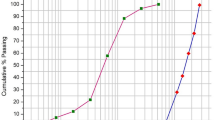Abstract
The effective atomic numbers (Z eff) and effective electron density (N e) of different type concrete have been measured and the results were compared with the calculation obtained using the mass attenuation coefficients (μ/ρ) obtained via XCOM in the photon energy range of 1 keV–100 GeV. Six different concrete in where marble has been used in the rate of 0, 5, 10, 15, 20, 25 %, has been used in the study.



Similar content being viewed by others
References
Akkurt I (2007) Effective atomic numbers for Fe-Mn alloy using transmission experiment. Chinese Phys Lett 24–10:2812
Akkurt I (2009) Effective atomic and electron numbers of some steels at different energies. Ann Nucl Energy 36(11–12):1702–1705
Akkurt I (2011) Determination of effective atomic number and electron density of chitin by gamma-ray attenuation. Int J Phys Sci 6:5048–5050
Akkurt I et al (2005) Study on Z dependence of partial and total mass attenuation coefficients. J Quantit Spect Radiat Transf 94(3–4):379–385
Akkurt I, Akyildirim H, Mavi B, Kilincarslan S, Basyigit C (2010) Gamma-ray shielding properties of concrete including barite at different energies. Prog Nucl Energy 52(1):620–623
Akkurt I et al (2012) Photon attenuation coefficients of concrete including marble aggregates. Ann Nucl Energy 43:56–60
Antoniassi M, Conceicão ALC, Poletti ME (2011) Study of effective atomic number of breast tissues determined using the elastic to inelastic scattering ratio. Instr Methods Phys Res A 652:739–743
Birgani MJT, Seif F, Chegeni N, Bayatiani MR (2012) Determination of the effective atomic and mass numbers for mixture and compound materials in high energy photon interactions. J Radioanal Nucl Chem 292:1367–1370
Demir D, Tursucu A (2012) Studies on mass attenuation coefficient, mass energy absorption coefficient and kerma of some vitamins. Ann Nucl Energy 48:17–20
Gowda S, Krishnaveni S, Gowda R (2005) Studies on effective atomic numbers and electron densities in amino acids and sugars in the energy range 30–1333 keV. Nucl Instrum Methods Phys Res B 239:361–369
Gurler O, Akar Tarim U (2012) An investigation on determination of attenuation coefficients for gamma-rays by Monte Carlo method. J Radioanal Nucl Chem. Doi: 10.1007/s10967-012-1749-3
Guru Prasad S et al (1998) Effective atomic numbers for photo absorption in alloys in the energy region of absorption edges. Rad Phys Chem 53:449–453
Hine GJ (1952) The effective atomic numbers of materials for various gamma ray interactions. Phys Rev 85:725
Icelli O et al (2005) Effective atomic numbers for CoCuNi alloys using transmission experiments. J Quant spect Radiat Transf 91:485–491
Kirdsiri K, Kaewkhao J, Limsuwan P (2012) Photon interaction in borate glass doped with Bi2O3 at different energies. Procedia Eng 32:727–733
Manohara SR, Hanagodimath SM (2007) Studies on effective atomic numbers and electron densities of essential amino acids in the energy range 1 keV–100 GeV. Nucl Instrum Methods Phys Res B Beam Interact Mater Atoms 258(2):321–328
Manohara SR, Hanagodimath SM, Thind KS et al (2008) On the effective atomic number and electron density: a comprehensive set of formulas for all types of materials and energies above 1 keV. Nucl Instrum Methods Phys Res B Beam Interact Mater Atoms 266(18):3906–3912
Manohara SR, Hanagodimath SM, Gerward L (2009) The effective atomic numbers of some biomolecules calculated by two methods: a comparative study. Med Phys 36(1):137–141
Mavi B (2012) Experimental investigation of <gamma>-ray attenuation coefficients for granites. Ann Nucl Energy 44:22–25
Medhat ME (2011) Studies on effective atomic numbers and electron densities in different solid state track detectors in the energy range 1 keV–100 GeV. Ann Nucl Energy 38:1252–1263
Medhat ME (2012) Study of the mass attenuation coefficients and effective atomic numbers in some gemstones. J Radioanal Nucl Chem 293:555–564
Murty VRK et al (2000) Effective atomic numbers for W/Cu alloy using transmission experiments. Appl Rad Isot 53:945–948
Rezaei-Ochbelagh D, Azimkhani S, Mosavinejad HG (2012) Shielding and strength tests of silica fume concrete. Ann Nucl Energy 45:150–154
Sharma R, Sharma V, Singh PS, Singh T (2012) Effective atomic numbers for some calcium-strontium-borate glasses. Ann Nucl Energy 45:144–149
Shivalinge G, Krishnaveni S, Ramakrishna G (2005) Studies on effective atomic numbers and electron densities in amino acids and sugars in the energy range 30–1333 keV. Nucl Inst Met Phys Res B 239–4:361–369
Shivaramu R, Vijayakumar R, Rajasekaran L et al (2001) Effective atomic numbers for photon energy absorption of some low-Z substances of dosimetric interest. Radiat Phys Chem 62(5–6):371–377
Sidhu BS, Dhaliwal AS, Mann KS, Kahlon KS (2012) Study of mass attenuation coefficients, effective atomic numbers and electron densities for some low Z compounds of dosimetry interest at 59.54 keV incident photon energy. Ann Nucl Energy 42:153–157
Woods J (1982) Computational methods in reactor shielding. Pergamon, New York
El-Khayatt AM and Akkurt I (submitted) Photon interaction, energy absorption and neutron removal cross section of concrete including marble
Author information
Authors and Affiliations
Corresponding author
Rights and permissions
About this article
Cite this article
Akkurt, I., El-Khayatt, A.M. Effective atomic number and electron density of marble concrete. J Radioanal Nucl Chem 295, 633–638 (2013). https://doi.org/10.1007/s10967-012-2111-5
Received:
Published:
Issue Date:
DOI: https://doi.org/10.1007/s10967-012-2111-5




